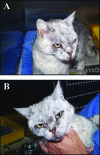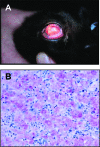Molecular characterization of a novel fastidious mycobacterium causing lepromatous lesions of the skin, subcutis, cornea, and conjunctiva of cats living in Victoria, Australia
- PMID: 18057130
- PMCID: PMC2238134
- DOI: 10.1128/JCM.01186-07
Molecular characterization of a novel fastidious mycobacterium causing lepromatous lesions of the skin, subcutis, cornea, and conjunctiva of cats living in Victoria, Australia
Abstract
Between 1999 and 2006, 15 cats were diagnosed with disease attributable to a novel mycobacterial species. The infections consisted of granulomatous lesions in the skin, subcutis, and ocular or periocular tissues with an indolent but progressive clinical course. Lesions typically were found in facial regions or on the distal limbs. Cats of all ages and both sexes were affected. Infections often were challenging to treat, although they could be cured using surgery in concert with combination antimicrobial therapy. Microscopically, lesions were granulomatous to pyogranulomatous and contained numerous acid-fast bacilli. Scanty cultures of the causal microorganisms occasionally could be obtained in mycobacterial broth, but subculture to solid media failed. When cultures were not available, DNA was extracted from fresh tissue, lyophilized material, and formalin-fixed, paraffin-embedded tissues from lesions. PCR amplification of the 5' end of the 16S rRNA gene and regions within four additional loci (ITS1, hsp65, rpoB, and sodA) was performed with various efficiencies using mycobacterial primers. Nucleotide sequences were unique for each locus tested. Nucleotide sequences obtained from individual cases were identical for each locus for which the amplification was successful. Phylogenetic analysis performed using concatenated partial 16S rRNA and hsp65 gene sequences indicated that this novel mycobacterial species from Victoria is a member of the Mycobacterium simiae-related group, taxonomically related to the mycobacterium causing leproid granulomas in dogs throughout the world. Based on the clustering of cases, we refer to this novel species as Mycobacterium sp. strain Tarwin.
Figures





References
-
- Davies, J. L., J. A. Sibley, S. Myers, E. G. Clark, and G. D. Appleyard. 2006. Histological and genotypical characterization of feline cutaneous mycobacteriosis: a retrospective study of formalin-fixed paraffin-embedded tissues. Vet. Dermatol. 17155-162. - PubMed
-
- Devulder, G., M. Perouse de Montclos, and J. P. Flandrois. 2005. A multigene approach to phylogenetic analysis using the genus Mycobacterium as a model. Int. J. Syst. Evol. Microbiol. 55293-302. - PubMed
MeSH terms
Substances
Associated data
- Actions
- Actions
- Actions
- Actions
- Actions
- Actions
- Actions
LinkOut - more resources
Full Text Sources
Medical
Molecular Biology Databases
Research Materials
Miscellaneous

